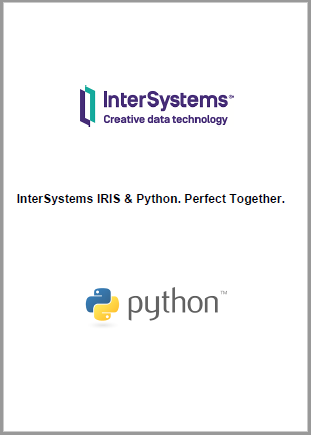文章目录
- 第六章 使用嵌入式 Python (三)
- 从 ObjectScript 调用嵌入式 Python 代码
- 使用 Python 库
- 调用用 `Python` 编写的 `IRIS` 类的方法
- 运行用 `Python` 编写的 `SQL` 函数或存储过程
- 运行任意 Python 命令
第六章 使用嵌入式 Python (三)
从 ObjectScript 调用嵌入式 Python 代码
使用 Python 库
嵌入式 Python 让可以轻松访问数以千计的有用库。通常称为“包”,它们需要从 Python 包索引 (PyPI) 安装到 <installdir>/mgr/python 目录中,然后才能使用。
例如,ReportLab Toolkit 是一个用于生成 PDF 和图形的开源库。以下命令使用软件包安装程序 irispip 在 Windows 系统上安装 ReportLab:
C:InterSystemsIRISbin>irispip install --target C:InterSystemsIRISmgrpython reportlab
在基于 UNIX 的系统上,使用:
$ pip3 install --target /InterSystems/IRIS/mgr/python reportlab
安装包后,可以使用 %SYS.Python 类的 Import() 方法在 ObjectScript 代码中使用它。
给定一个文件位置,以下 ObjectScript 方法 CreateSamplePDF() 创建一个示例 PDF 文件并将其保存到该位置。
Class Demo.PDF
{
ClassMethod CreateSamplePDF(fileloc As %String) As %Status
{
set canvaslib = ##class(%SYS.Python).Import("reportlab.pdfgen.canvas")
set canvas = canvaslib.Canvas(fileloc)
do canvas.drawImage("C:Sampleisc.png", 150, 600)
do canvas.drawImage("C:Samplepython.png", 150, 200)
do canvas.setFont("Helvetica-Bold", 24)
do canvas.drawString(25, 450, "InterSystems IRIS & Python. Perfect Together.")
do canvas.save()
}
}
该方法的第一行从 ReportLab 的 pdfgen 子包中导入 canvas.py 文件。第二行代码实例化一个 Canvas 对象,然后继续调用它的方法,这与调用任何 IRIS 对象的方法很相似。
然后,可以以通常的方式调用该方法:
do ##class(Demo.PDF).CreateSamplePDF("C:Samplehello.pdf")
在指定位置生成并保存以下 PDF:

调用用 Python 编写的 IRIS 类的方法
可以使用嵌入式 Python 在 IRIS 类中编写方法,然后从 ObjectScript 调用它,就像调用用 ObjectScript 编写的方法一样。
下一个示例使用 usaddress-scourgify 库,可以从 Windows 上的命令行安装,如下所示:
C:InterSystemsIRISbin>irispip install --target C:InterSystemsIRISmgrpython usaddress-scourgify
在基于 UNIX 的系统上,使用:
$ pip3 install --target /InterSystems/IRIS/mgr/python usaddress-scourgify
下面的演示类包含美国地址部分的属性和一个用 Python 编写的方法,该方法使用 usaddress-scourgify 根据美国邮政服务标准对地址进行规范化。
Class Demo.Address Extends %Library.Persistent
{
Property AddressLine1 As %String;
Property AddressLine2 As %String;
Property City As %String;
Property State As %String;
Property PostalCode As %String;
Method Normalize(addr As %String) [ Language = python ]
{
from scourgify import normalize_address_record
normalized = normalize_address_record(addr)
self.AddressLine1 = normalized['address_line_1']
self.AddressLine2 = normalized['address_line_2']
self.City = normalized['city']
self.State = normalized['state']
self.PostalCode = normalized['postal_code']
}
}
给定地址字符串作为输入,类的 Normalize() 实例方法规范化地址并将每个部分存储在 Demo.Address 对象的各种属性中。
可以按如下方式调用该方法:
USER>set a = ##class(Demo.Address).%New()
USER>do a.Normalize("One Memorial Drive, 8th Floor, Cambridge, Massachusetts 02142")
USER>zwrite a
a=3@Demo.Address <OREF>
+----------------- general information ---------------
| oref value: 3
| class name: Demo.Address
| reference count: 2
+----------------- attribute values ------------------
| %Concurrency = 1 <Set>
| AddressLine1 = "ONE MEMORIAL DR"
| AddressLine2 = "FL 8TH"
| City = "CAMBRIDGE"
| PostalCode = "02142"
| State = "MA"
+-----------------------------------------------------
运行用 Python 编写的 SQL 函数或存储过程
当使用嵌入式 Python 创建 SQL 函数或存储过程时, IRIS 会投影一个具有可从 ObjectScript 调用的方法的类,就像使用任何其他方法一样。
例如,本文档前面示例中的 SQL 函数会生成一个类 User.functzconvert,它有一个 tzconvert() 方法。从 ObjectScript 调用它,如下所示:
USER>zwrite ##class(User.functzconvert).tzconvert($zdatetime($h,3),"US/Eastern","UTC")
"2021-10-20 15:09:26"
这里,$zdatetime($h,3) 用于将当前日期和时间从 $HOROLOG 格式转换为 ODBC 日期格式。
运行任意 Python 命令
有时,当开发或测试嵌入式 Python 代码时,从 ObjectScript 运行任意 Python 命令会很有帮助。可以使用 %SYS.Python 类的 Run() 方法来执行此操作。
也许想测试本文档前面使用的 usaddress_scourgify 包中的 normalize_address_record() 函数,但不记得它是如何工作的。可以使用 %SYS.Python.Run() 方法从终端输出函数的帮助,如下所示:
USER>set rslt = ##class(%SYS.Python).Run("from scourgify import normalize_address_record")
USER>set rslt = ##class(%SYS.Python).Run("help(normalize_address_record)")
Help on function normalize_address_record in module scourgify.normalize:
normalize_address_record(address, addr_map=None, addtl_funcs=None, strict=True)
Normalize an address according to USPS pub. 28 standards.
Takes an address string, or a dict-like with standard address fields
(address_line_1, address_line_2, city, state, postal_code), removes
unacceptable special characters, extra spaces, predictable abnormal
character sub-strings and phrases, abbreviates directional indicators
and street types. If applicable, line 2 address elements (ie: Apt, Unit)
are separated from line 1 inputs.
.
.
.
%SYS.Python.Run() 方法在成功时返回 0,在失败时返回 -1。
最后
以上就是还单身硬币最近收集整理的关于第六章 使用嵌入式 Python (三)第六章 使用嵌入式 Python (三)从 ObjectScript 调用嵌入式 Python 代码的全部内容,更多相关第六章内容请搜索靠谱客的其他文章。








发表评论 取消回复